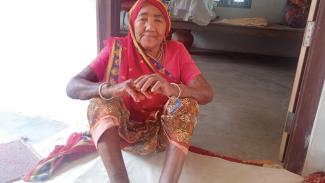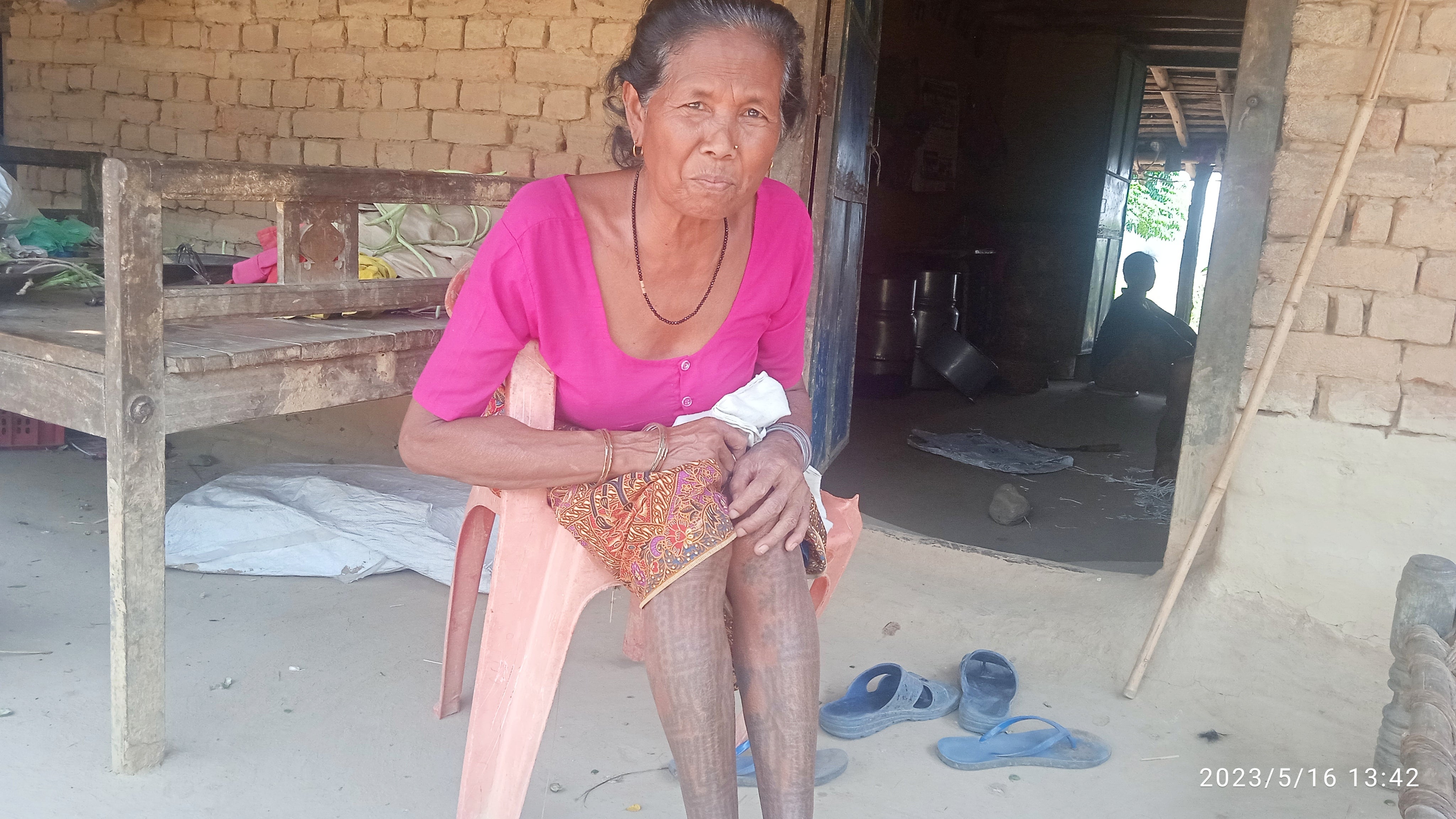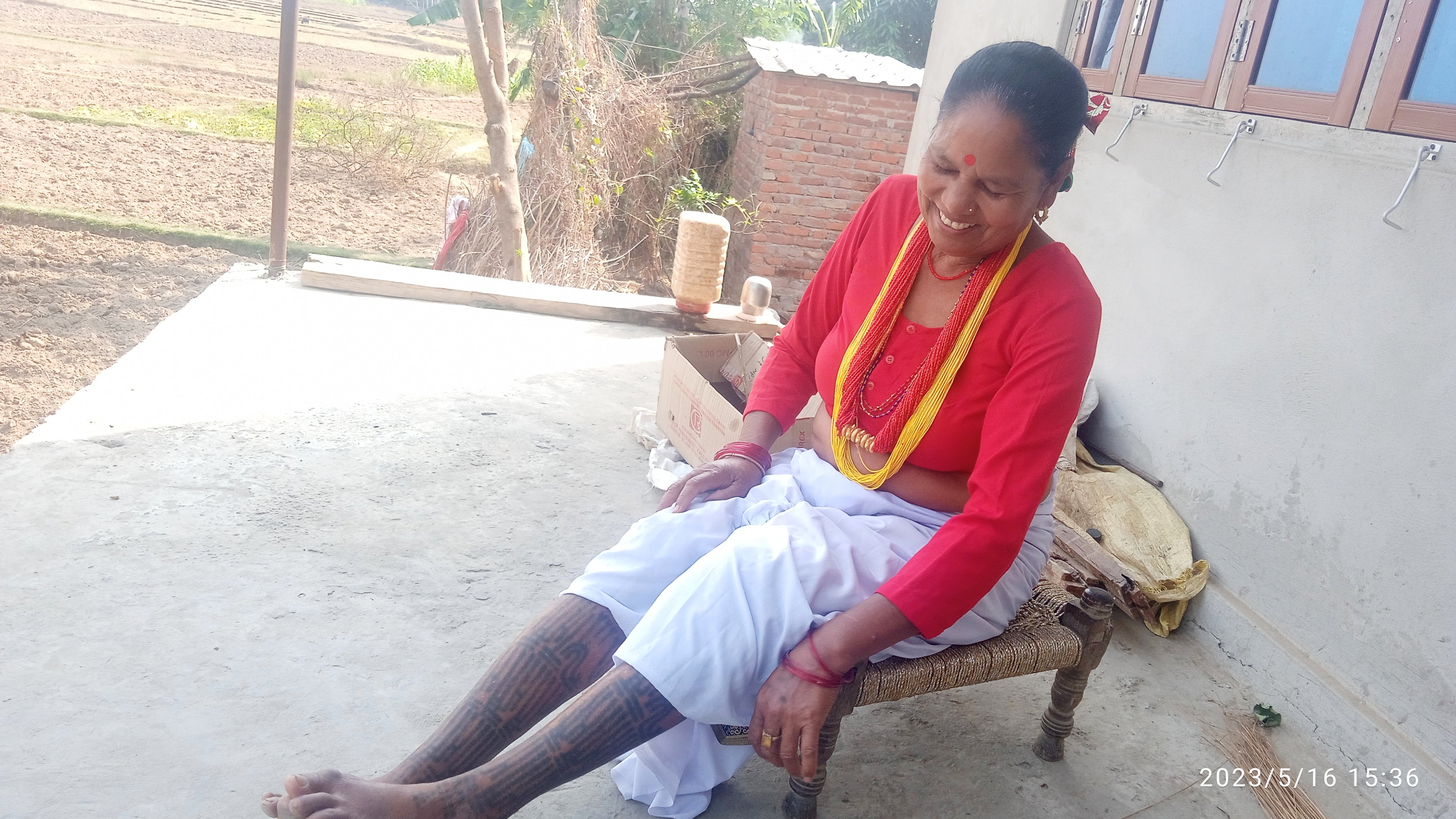
In Nepal, tattooing has long been an integral part of life, culture, and identity for many Indigenous communities, particularly for Tharu Indigenous women from the southern parts of the country. Tharu Indigenous Peoples live in over 20 different districts in the southern plains in Nepal. According to the 2011 Census, their population is 1.73 million. Tharu Peoples have their own district language, culture, rituals, customs, and lifeways.
Tattooing is an art that is distinct from other forms of expression. However, the practice of traditional tattooing is fading in popularity, especially among younger generations. Tattoos among Tharu women carry different stories. Inspired mostly by nature, Tharu women traditionally used tattoos to carry forward their traditional values and cultural identities. In some regions, it was compulsory for young girls before marriage, and for married women, especially on the legs. Tharu communities are animists and believe in the forest goddess Bandevi and other nature-based deities. The tattoos reflect these beliefs.
“I was inspired while looking at others and I tattooed my legs only with a few symbols. All my friends back then, in my early teens, would tattoo their bodies,” says Somali Tharu, 75, living in Bashgadhi Municipality-4, Laxmanpur. “After giving birth to two babies, I tattooed my hands and other parts of my body, mainly with the symbols of birds, harin (deer), mayur (peacocks), weavings, a cooking pot, and machiya (wooden table), and [I] had a tika (mark on the forehead) done."
“My grandmother and my mother had tattoos throughout their bodies and I followed the tradition. All my female relatives had tattoos on their bodies. I don’t know why people stopped tattooing tikas. In the past, Tharu men also used to get tattooed with a few symbols, such as their name and symbols of birds or flowers. When people would ask their name, they would show their hand. Tharu women would put various marks on their hands, legs and face,” Tharu says.
The term for tattoos in the Tharu language is khodna, or godna. They are done in patterns such as lines, dots, and crosses on the arms, legs, and chest, and reflect elements in nature, such as badam butta (groundnut shrub), suraj ke daali (rays of the sun), supari ke gacha (betel nut palm), along with peacocks, cooking pots, snakes, temples, and hearts, among others.
Tattoos are believed to be a protection from being kidnapped and kept as enslaved people by royals, who apparently disliked tattoos of Indigenous cultures. Tattoos were, and are, also used for enhancing beauty. They are regarded as a lifelong ornament on women. However, Tharu youth are not getting traditional tattoos, and experienced tikaniyas (tatoo artists) are hard to come by in the villages. Instead, western tattoos have become increasingly fashionable and trendy and use modern tattooing guns and other non-traditional methods.
“This is the symbol of bird, machiya, mayur, hasiya (sickle), and this is venta (Nepali eggplant),” says Lalrani Tharu, 52, from Bashgadhi-4. “I don’t know the reasons behind the tattoos, but I like tattooing. Back then, we did not go to school. After completing housework, we friends would sit and pierce each other, mostly to decorate our bodies.” Tattooing by the tikaniya, or gudhni (carving and designs expert) is a painful process. The natural black ink is obtained from the soot of a kerosene lamp and rubbed with cow dung to clean it afterward. After drying, mustard oil is applied to soften the skin surface.
 Bismani Chaudhary (Tharu).
Bismani Chaudhary (Tharu).
“This tika is to look good. If we have tika on the forehead and some symbol on the chin, we look beautiful,” says Bismani Chaudhary, 76, from Bashgadhi Municipality-4, Bathuwatal. “Tattoos symbolize our purity and, in any ceremony, if you don’t have tattoos or piercings, then women are not allowed to cook food. At the time of big weddings, those who didn’t have tattoos were considered impure, thus they also got tattoos.”
In addition to their aesthetic value, Tharu women also get tattoos as a symbol of maturity. When a young girl reaches puberty, she is able to get tattooed. The designs relate to their sociocultural surroundings, God and deities, and other symbols. The tattoos carry their own significance for the tattooed person, signifying spirituality, fashion, memories, and personal style.
Tattoos are also a traditional practice of Newar Indigenous Peoples. They use different kinds of images on their bodies either temporarily or as permanent tattoos. The most frequent images they use are the half-moon, animals, birds, plants, divine emblems, or deities. The images of gods and goddesses like Bhairab, Ganesh, and Shiva, as well as the tiki-jhya (latticed window), are used to decorate the upper parts of the body, and the animals, birds and plants are sketched on the lower limbs. The Newar believe that tattoos assure their protection in the present life, driving away misfortune, and are a treasure for the next life.
The Newar term for traditional tattooing is Lha-Chyogu (writing on the flesh). With the changing times, the beliefs and purposes of tattooing have also changed. Today, tattoos have become more of a fashion statement and a means of expression. Tamang, Gurung, Magar, and Sunuwar women also have tattooing practices with different purposes. They mostly adorn their chins, hands, or legs with symbols of animals, plants, or hearts. Tattoos are not only designs, but visual expressions of Indigenous cultures. Folktales, myths, and beliefs are reflected in tattoos and are part of the intangible cultural heritage of Indigenous Peoples. Intergenerational knowledge transfer also occurs through the use this visual language.
 Kalpana Chaudhary (Tharu).
Kalpana Chaudhary (Tharu).
There is a prevalent belief among Tharu Peoples that on the way to heaven, if one faces hardships, they can sell their tattoos and make it to heaven more easily. Likewise, after death, jewelry can’t be taken to the afterlife, but the tattoos accompany the person. “When we die, we don’t get to take money or clothes. But this tattoo remains forever and goes with us,” says Kalpana Chaudhary, 53, from Bashgadhi, Municipality-4. “When we die, no one goes with us as a friend. At the time of cremation of our body, clothes, and jewels are removed and thrown away, and the only thing remaining on our skin are the tattoos and the memories that are attached to them. Moreover, if we have a tika, God will take us to heaven,” she says.
“My grandmother and my mother had tattoos and so do I. Now tattooing practice has almost gone extinct. I don’t see Tharu women piercing their bodies with tattoos, and younger generations have gone to cities and tattooed [themselves] with different symbols without any meaning. Nowadays, our girls don’t like our tattoos,” Chaudhary says. Because young girls are shying away from tattooing traditions, Tharu Elders are concerned about its continuity. In the past, tattooing was also common among Tharu men, usually on the neck, hands, and legs. But the younger generations no longer want to get tattoos as they are attracted to western cultures and see the tradition as outdated. It appears this decline is linked to the loss of Indigenous Traditional Knowledge and the younger generations are not aware of the cultural significance behind the traditional tattoos.
“My mother has only a small tattoo on her leg. In my village, we hardly saw grannies with tattoos. We were never told any stories related to tattoos, thus we were never attracted to tattoos,” says Urmila Gamwa Tharu (Tharu), a Tharu language television program producer from Kanchanpur and presenter known as Chali-Gochali at Indigenous Television. “But having visited other Tharu villages and after listening to stories about tattoo arts, now I am interested in getting some traditional tattoos.”
Anoj Tharu (Tharu) is a staff reporter at Indigenous Television in Nepal.
Top photo: Somali Tharu (Tharu) shows off her traditional tattoos.
All photos by Anoj Tharu.
